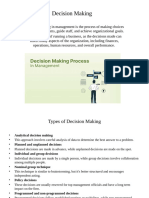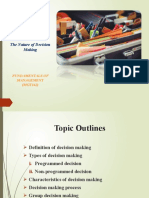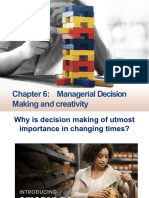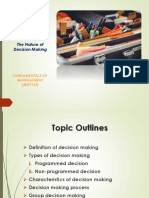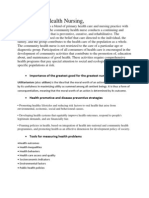0 ratings0% found this document useful (0 votes)
Report in CFLM
Uploaded by
jovellodenaProblem-solving involves defining a problem, determining its cause, identifying alternatives, selecting a solution, and implementing it. Decision-making is choosing between options by identifying decisions, gathering information, and assessing alternatives. While problem-solving focuses on finding logical solutions, decision-making evaluates alternatives to meet needs. The key difference is that problem-solving seeks to resolve issues while decision-making selects the best option from available choices.
Copyright:
© All Rights Reserved
Available Formats
Download as PPTX, PDF, TXT or read online from Scribd
Download as pptx, pdf, or txt
Report in CFLM
Uploaded by
jovellodena0 ratings0% found this document useful (0 votes)
Problem-solving involves defining a problem, determining its cause, identifying alternatives, selecting a solution, and implementing it. Decision-making is choosing between options by identifying decisions, gathering information, and assessing alternatives. While problem-solving focuses on finding logical solutions, decision-making evaluates alternatives to meet needs. The key difference is that problem-solving seeks to resolve issues while decision-making selects the best option from available choices.
Copyright
© © All Rights Reserved
Available Formats
PPTX, PDF, TXT or read online from Scribd
Share this document
Did you find this document useful?
Is this content inappropriate?
Problem-solving involves defining a problem, determining its cause, identifying alternatives, selecting a solution, and implementing it. Decision-making is choosing between options by identifying decisions, gathering information, and assessing alternatives. While problem-solving focuses on finding logical solutions, decision-making evaluates alternatives to meet needs. The key difference is that problem-solving seeks to resolve issues while decision-making selects the best option from available choices.
Copyright:
© All Rights Reserved
Available Formats
Download as PPTX, PDF, TXT or read online from Scribd
Download as pptx, pdf, or txt
0 ratings0% found this document useful (0 votes)
Report in CFLM
Uploaded by
jovellodenaProblem-solving involves defining a problem, determining its cause, identifying alternatives, selecting a solution, and implementing it. Decision-making is choosing between options by identifying decisions, gathering information, and assessing alternatives. While problem-solving focuses on finding logical solutions, decision-making evaluates alternatives to meet needs. The key difference is that problem-solving seeks to resolve issues while decision-making selects the best option from available choices.
Copyright:
© All Rights Reserved
Available Formats
Download as PPTX, PDF, TXT or read online from Scribd
Download as pptx, pdf, or txt
You are on page 1/ 20
PROBLEM-SOLVING VS.
DECISION-MAKING
(Characteristics and Differences)
Jovell Gliponeo Odeña
III- Hotel
Ms. Jinky Aguilar
Instructor
What is Problem-solving and
Decision-making?
PROBLEM-SOLVING
• the act of defining a problem; determining the cause of the problem;
identifying, prioritizing, and selecting alternatives for a solution; and
implementing a solution.
• is the process of achieving a goal by overcoming obstacles, a frequent
part of most activities. Problems in need of solutions range from simple
personal tasks to complex issues in business and technical fields.
• enables to identify and exploit opportunities in the environment and
exert (some level of) control over the future. Problem solving skills and
the problem-solving process are a critical part of daily life both as
individuals and organizations.
CHARACTERISTICS OF PROBLEM-
SOLVING
1. Define the problem
2. Generate options
3. Evaluate and choose an option
4. Implement the solution
Define the problem
• Differentiate fact from opinion
• Specify underlying causes
• Consult each faction involved for information
• State the problem specifically
• Identify what standard or expectation is violated
• Determine in which process the problem lies
• Avoid trying to solve the problem without data
Generate alternative solutions
• Postpone evaluating alternatives initially
• Include all involved individuals in the generating of
alternatives
• Specify alternatives consistent with organizational goals
• Specify short- and long-term alternatives
• Brainstorm on others' ideas
• Seek alternatives that may solve the problem
Evaluate and select an alternative
• Evaluate alternatives relative to a target standard
• Evaluate all alternatives without bias
• Evaluate alternatives relative to established goals
• Evaluate both proven and possible outcomes
• State the selected alternative explicitly
Implement and follow up on the solution
• Plan and implement a pilot test of the chosen
alternative
• Gather feedback from all affected parties
• Seek acceptance or consensus by all those affected
• Establish ongoing measures and monitoring
• Evaluate long-term results based on final solution
DECISION-MAKING
• is the process of making choices by identifying a decision, gathering
information, and assessing alternative resolutions.
• is a process of choosing between possibilities. It is often part of
problem solving. The more complex the decision, the more factors
you'll need to consider before deciding on a course of action.
• defined as a course of action purposely chosen from a set of
alternatives to achieve organizational or managerial objectives or
goals.
• the rational process in which managers choose the right option out of
many which is supportive of organizational goals achievement.
CHARACTERISTICS OF DECISION-
MAKING
• Goal Oriented
• Continuous Process
• Selective Process
• Dynamic Process
• Rational Process
• Pervasive in Nature
• Negative or Positive Impact
• Solves Specific Problems
• End Product
Goal Oriented
• Decision-making is a goal-oriented component
of management. During the course of the organization,
managers have to make decisions considering the
achievement of organizational goals and objectives.
• All the decisions made in the organization by the top or lower
managers are directed toward the overall goals of the
organization. For this, managers are responsible for making
the right as well as an effective decision that ensures better
goal achievement.
Continuous Process
• Decision-making is a continuous process that remains
in the organization till it is left. Managers as well as
other employees need to make several decisions every
day.
• From entering the organization (office) to managing
different activities and employees, to leaving the office
managers have to make many decisions based on time,
requirements, and situations.
Selective Process
Decision-making is also selective in nature. It
is a process of selecting the best option from
the pool of available options. Managers have
to select the best alternative that has greater
potential to ensure goal achievement after
careful evaluation of all alternatives.
Dynamic Process
• It is obvious that today’s business environment is dynamic in
nature. It is necessary that managers should consider the
dynamic and changeable environmental factors while making
any decisions.
• For the effectiveness of decisions, managers have to make
decisions on time. In addition, they should consider the future
impact of the decision and how the decision will be affected
in the future by possible conditions.
Rational Process
• Because all decisions are founded on logical considerations to make
them more rational, making decisions is an intellectual and rational
process. Before making a choice, managers must use their capacity for
rational thought to comprehend the potential effects of
possible options.
• They require a certain amount of mental capacity, intelligence,
knowledge, experience, and personal abilities. Similar to this, in
addition to intellectual logic, the voice of inner consciousness is also
significant while making decisions.
Pervasive in Nature
• Decision-making is also characterized as being pervasive in nature.
Decision-making is needed at all management levels, in all
organizations, and in all functional areas of the workplace.
• Top managers, lower managers, employees, workers, etc. all make
some decisions at their end in the workplace. Top managers’ decisions
affect the performance of lower-level employees while their decisions
affect the completion of given tasks.
• Decision-making is common everywhere whether in personal life or
professional life.
Negative or Positive Impact
• Managers make different decisions assuming the decision
will support the goal accomplishment. But the fact is, the
alternative will have both negative and positive impacts on
organizational goal achievement or performance.
• However, managers should carefully analyze the available
alternatives and select the one that has a positive impact on
organizational performance. In addition, if he has to choose
from two negative ones he must choose one that has a less
negative impact.
Solves Specific Problems
As the decision-making is directed toward the
achievement of organizational goals
achievement is also directed toward resolving
specific problems. The decision-making
process starts with the identification of
problems, finding their solutions, and ends
with possible solutions.
End Product
• From the list of 9 characteristics of decision-making, the end
product is the last characteristic. Decision-making is the end
product in the sense that a decision is made only after a series
of experiments, analyses, and discussions.
• Because the decision is the main conclusion after the
discussions it is considered the end product. In addition,
whenever we discuss something at the end we come to a
conclusion which is a decision.
Differences of Problem-solving and
Decision-making
To make the conclusion short, Decision making has much in
common with problem solving. In problem solving you
identify and evaluate solution paths; in decision making you
make a similar discovery and evaluation of alternatives.
Additionally, Problem-solving is all about using logic, as well
as imagination, to make sense of a situation and come up with
an intelligent solution wherein, Decision-making is a series of
steps taken by an individual to determine the best option or
course of action to meet their needs.
You might also like
- Decision Making: Dr. T V Suresh Kumar Prof. and Head, Registrar (Academic) Ramaiah Institute of TechnologyNo ratings yetDecision Making: Dr. T V Suresh Kumar Prof. and Head, Registrar (Academic) Ramaiah Institute of Technology22 pages
- 4. SIMON'S DECISION MAKING & MANAGEMENT INFORMATION SYSTEMNo ratings yet4. SIMON'S DECISION MAKING & MANAGEMENT INFORMATION SYSTEM44 pages
- Unit 4 the Decision Making the Essence of the Manager's Job.pptxNo ratings yetUnit 4 the Decision Making the Essence of the Manager's Job.pptx25 pages
- EE 413 - Engg Management: Decision MakingNo ratings yetEE 413 - Engg Management: Decision Making30 pages
- Chapter 4 Managerial Decision Making QTKDLTNo ratings yetChapter 4 Managerial Decision Making QTKDLT29 pages
- Decision Making (DM) : - Every Manager Strives To Do Making Good DecisionsNo ratings yetDecision Making (DM) : - Every Manager Strives To Do Making Good Decisions30 pages
- Chapter 2.Decision Making - Student CopyNo ratings yetChapter 2.Decision Making - Student Copy23 pages
- CH 6 Managerial Decision Making and Creativity100% (1)CH 6 Managerial Decision Making and Creativity58 pages
- Organizational Decision Making: Sreenath BNo ratings yetOrganizational Decision Making: Sreenath B32 pages
- Lesson 10. The Importance of Employee MotivationNo ratings yetLesson 10. The Importance of Employee Motivation14 pages
- Father Saturnino Urios University: Bp. Pueblos Senior High School Butuan CityNo ratings yetFather Saturnino Urios University: Bp. Pueblos Senior High School Butuan City46 pages
- Watermark Engineering Services.: ContentsNo ratings yetWatermark Engineering Services.: Contents15 pages
- Impact of Employee Motivation On Perform PDFNo ratings yetImpact of Employee Motivation On Perform PDF7 pages
- Quality in The Medieval Guilds of EuropeNo ratings yetQuality in The Medieval Guilds of Europe26 pages
- Module 1-Introduction To Strategic ManagementNo ratings yetModule 1-Introduction To Strategic Management138 pages
- Redefining Student Leadership by Yannick UgwunaliNo ratings yetRedefining Student Leadership by Yannick Ugwunali5 pages
- "Preparation of Electoral Roll With Photograph (PERP) and Facilitating The Issuance of National Identity Card (FINIDC) ".No ratings yet"Preparation of Electoral Roll With Photograph (PERP) and Facilitating The Issuance of National Identity Card (FINIDC) ".55 pages
- Session 2 - MIS-Define & Systems Approach V1No ratings yetSession 2 - MIS-Define & Systems Approach V119 pages
- Polytechnic University of The Philippines: Sta. Mesa, Manila Department of Psychology100% (1)Polytechnic University of The Philippines: Sta. Mesa, Manila Department of Psychology3 pages
- Land Use Policy Impacts On Human Development in The PhilsNo ratings yetLand Use Policy Impacts On Human Development in The Phils19 pages
- Values Provinces Goal Towns Top of Map Ultimate Goal/value You Have Bottom Definition of SuccessNo ratings yetValues Provinces Goal Towns Top of Map Ultimate Goal/value You Have Bottom Definition of Success3 pages
- Effect of Performance Management System On Employee Performance A Study of Food and Agriculture OrganizationNo ratings yetEffect of Performance Management System On Employee Performance A Study of Food and Agriculture Organization82 pages
- Chapter 2 - COMPENSATION RESPONSIBILITIES, SYSTEM DESIGN ISSUES, PHILOSOPHIES AND APPROACHESNo ratings yetChapter 2 - COMPENSATION RESPONSIBILITIES, SYSTEM DESIGN ISSUES, PHILOSOPHIES AND APPROACHES8 pages
- Decision Making: Dr. T V Suresh Kumar Prof. and Head, Registrar (Academic) Ramaiah Institute of TechnologyDecision Making: Dr. T V Suresh Kumar Prof. and Head, Registrar (Academic) Ramaiah Institute of Technology
- 4. SIMON'S DECISION MAKING & MANAGEMENT INFORMATION SYSTEM4. SIMON'S DECISION MAKING & MANAGEMENT INFORMATION SYSTEM
- Unit 4 the Decision Making the Essence of the Manager's Job.pptxUnit 4 the Decision Making the Essence of the Manager's Job.pptx
- Decision Making (DM) : - Every Manager Strives To Do Making Good DecisionsDecision Making (DM) : - Every Manager Strives To Do Making Good Decisions
- Decide Well: Tools for Effective Decision MakingFrom EverandDecide Well: Tools for Effective Decision Making
- Father Saturnino Urios University: Bp. Pueblos Senior High School Butuan CityFather Saturnino Urios University: Bp. Pueblos Senior High School Butuan City
- "Preparation of Electoral Roll With Photograph (PERP) and Facilitating The Issuance of National Identity Card (FINIDC) "."Preparation of Electoral Roll With Photograph (PERP) and Facilitating The Issuance of National Identity Card (FINIDC) ".
- Polytechnic University of The Philippines: Sta. Mesa, Manila Department of PsychologyPolytechnic University of The Philippines: Sta. Mesa, Manila Department of Psychology
- Land Use Policy Impacts On Human Development in The PhilsLand Use Policy Impacts On Human Development in The Phils
- Values Provinces Goal Towns Top of Map Ultimate Goal/value You Have Bottom Definition of SuccessValues Provinces Goal Towns Top of Map Ultimate Goal/value You Have Bottom Definition of Success
- Effect of Performance Management System On Employee Performance A Study of Food and Agriculture OrganizationEffect of Performance Management System On Employee Performance A Study of Food and Agriculture Organization
- Chapter 2 - COMPENSATION RESPONSIBILITIES, SYSTEM DESIGN ISSUES, PHILOSOPHIES AND APPROACHESChapter 2 - COMPENSATION RESPONSIBILITIES, SYSTEM DESIGN ISSUES, PHILOSOPHIES AND APPROACHES




